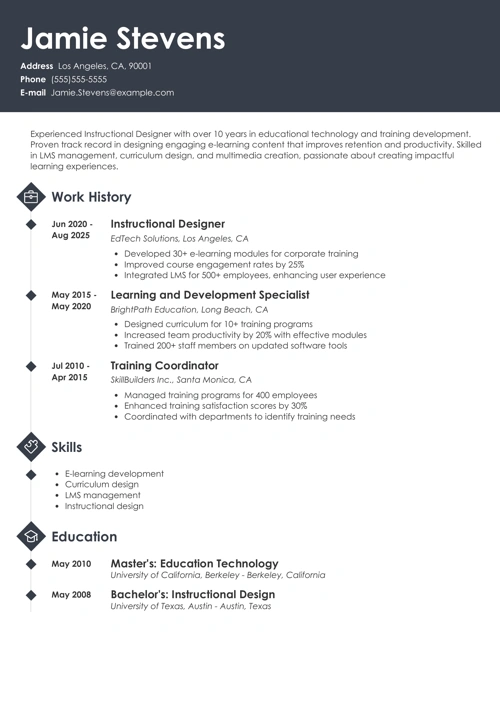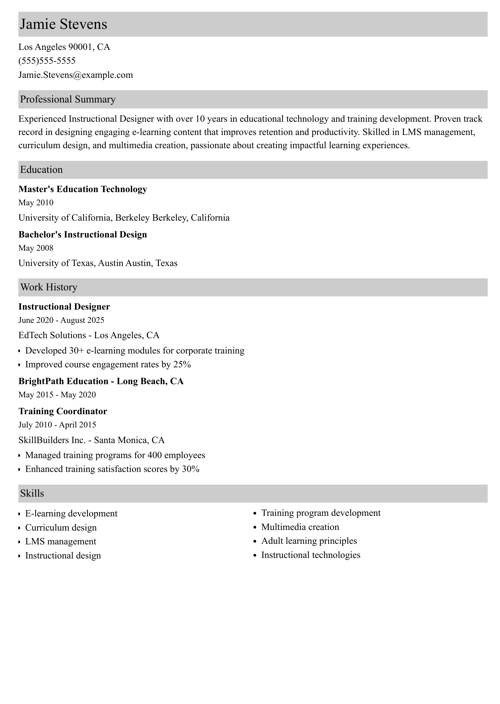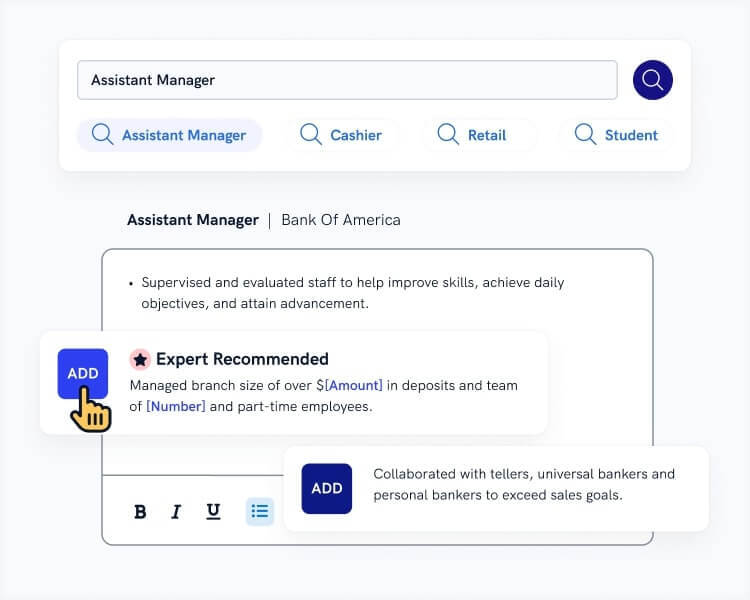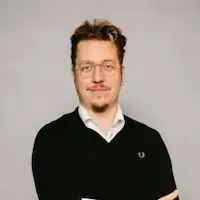Crafting the perfect instructional designer resume is your first step toward landing a role where creativity meets education. As an instructional designer, you are the architect of engaging learning experiences. This article provides expert tips and examples to help you build a resume that highlights your skills and sets you apart from the competition.
This guide will show you:
- An instructional designer resume example that’s better than 9 out of 10 other resumes.
- How to write an instructional designer resume that will land you more interviews.
- Tips and examples of how to put skills and achievements on an instructional designer resume.
- How to describe your experience on a resume for an instructional designer to get any job you want.
Want to save time and have your resume ready in 5 minutes? Try our resume builder. It’s fast and easy to use. Plus, you’ll get ready-made content to add with one click. See 20+ resume templates and create your resume here.
Sample resume made with our builder—See more resume examples here.
One of our users, Brittanya, had this to say:
Zety really helped me create the best resume possible. It pointed out how things could be better on my existing resume and suggested many things to be re-worded or removed.
Want to check more samples related to instructional designer? Here you go:
- Graphic Designer Resume
- Web Designer Resume
- Game Designer Resume
- UX Designer Resume & UI Developer Resume
- UX Researcher Resume
- React Developer Resume
- Teacher Resume
- Paraprofessional Resume
- Education Resume Examples
- Check Sample Resumes to Land Any Job
Instructional Designer Resume Sample
Jamie Stevens
Instructional Designer
jamie.stevens@protonmail.com
(312) 746-9927
linkedin.com/JamieStevens
Summary
Dynamic instructional designer with 10+ years of experience creating impactful learning programs. Launched an interactive knowledge-sharing platform, improving team efficiency by 40%. Developed over 30 professional development courses on schedule, supporting a company-wide upskilling initiative. Eager to drive educational excellence at Synapse Learning Solutions.
Work Experience
Senior Instructional Designer
EduGrowth Innovations, Chicago, IL
May 2018–Present
- Designed and implemented comprehensive learning solutions to enhance employee skills and improve organizational performance.
- Conducted needs analysis and developed training resources for 5,200 users, including storyboards, participant guides, and both CBT and ILT modules.
- Integrated eLearning best practices to build a modular learning library, cutting design time by 75%.
- Partnered with vendors from Germany, Brazil, and South Korea to localize training content for global teams.
Key Achievement:
- Initiated a collaborative documentation platform that reduced resource search time, leading to a $1.2M increase in productivity annually.
Instructional Designer
MindWorks Solutions, Austin, TX
April 2014–May 2018
- Worked closely with subject matter experts to develop training materials that improved learning engagement and retention by 55%.
- Created and tested assessment tools for multiple courses, including pilot evaluations for new eLearning modules.
- Redesigned customer support training curriculum for call centers in Canada, decreasing training time by 25%.
- Developed rapid prototyping methods, reducing course development time by 35% and increasing delivery speed.
Key Achievement:
- Produced over 30 development courses a month ahead of schedule, contributing to MindWorks' successful professional certification initiative.
Education
Master’s Degree in Instructional Design
University of Texas, Austin, TX
September 2012–May 2014
- GPA: 3.9
Key Skills
- Instructional Strategy
- Project Leadership
- Facilitation & Coaching
- Creativity & Innovation
- Adobe Captivate
- Articulate 360
- LMS Administration
- Graphic Design Basics
- MS Visio
- Data Analytics for Learning
Certifications
- Certified Professional in Training Management (CPTM)
- Instructional Design Certificate (IDC)
Languages
- Spanish — Professional Proficiency
Hobbies
- Photography
- Hiking and Nature Exploration
- Digital Art
- Volunteering for Local Educational Nonprofits
Publications
- "Innovative Approaches to Blended Learning," Learning Design Journal, 2021
- "Digital Learning Trends for 2022," eLearning Industry Blog, 2022
- "Leveraging Data in Instructional Design," Journal of Educational Innovation, 2023
Here’s how to write your own instructional designer resume:
1. Format Your Instructional Designer Resume Correctly
Your instructional designer resume needs to make a striking impression. With many applicants vying for the same role, your resume must stand out. So, how do you make that happen? A well-structured resume format can make all the difference.
Here’s how to format your resume for instructional designer positions:
- Begin with a resume header. Include your essential contact details: your full name, phone number, and email address.
- Add a LinkedIn profile to make the recruiter’s job easier.
- Don’t include your street address, but mention your city if it's the same as the company's location.
- Go for a reverse-chronological resume format, which is a popular resume style preferred by hiring managers as it lists your most recent job first, once again helping them to see what’s the most important.
- Select a professional font like Arial, Calibri, or Times New Roman.
- Set the font size between 10 to 12 points.
- Name your resume file as “Your Name—Instructional Designer—Resume.pdf.”
- Save your document as a PDF file to ensure that your layout remains intact.
- A one-page resume is ideal for entry-level resumes. However, if you have extensive relevant experience and achievements, consider a two-page resume or longer.
Pro Tip: Your recruiter will surely Google you before inviting you over. Always check your online presence to make sure everything looks 100% professional.
2. Tailor Your Instructional Designer Job Description
As an instructional designer, you must understand your learners and what they need. You should take a similar approach when applying for a job. Always customize your resume to meet the needs of your recruiters. Start with your work experience section, perhaps the most important part of your resume.
Here’s how to do it right:
- Use the exact position from the job listing. ATS systems favor precise job titles.
- List the company's name, location, and employment dates.
- Build each entry using 3–6 bullet points detailing your responsibilities and achievements.
- Demonstrate your skills with quantifiable accomplishments. Highlight the achievements that make your resume shine by using metrics and key performance indicators (KPIs).
- Begin bullet points with strong action verbs like developed, designed, and implemented.
Instructional Designer Responsibilities for a Resume - Example
- Design engaging and effective learning experiences using multimedia elements.
- Collaborate with subject matter experts to identify training needs and solutions.
- Create detailed instructional materials, including e-learning modules and manuals.
- Evaluate the effectiveness of instructional programs through feedback and assessments.
- Utilize learning management systems (LMS) to deploy and track educational content.
- Integrate new technologies and methodologies to enhance learning outcomes.
- Conduct workshops and training sessions to support learning initiatives.
Remember to use action verbs that convey your responsibilities and achievements effectively.
Here are some action verbs for instructional designers:
Instructional Designer Resume Action Verbs - Example
- Developed
- Designed
- Implemented
- Facilitated
- Evaluated
- Collaborated
- Innovated
- Produced
- Enhanced
- Delivered
Make sure to focus on what’s the most suitable for the job you’re after. Read more: Relevant Experience on a Resume
3. Make Your Education Section Count
Approximately 60% of instructional design positions require a master's degree, 25% require a bachelor's degree, and 11% require a post-master’s certificate. Make sure to show that on your resume education section. But don’t stop there. Use this resume section wisely to create a resume that truly stands out among others!
Here’s how to do it right:
- Place your educational qualifications just after your work experience.
- For those just starting out, include relevant coursework and extracurricular activities to illustrate your capabilities.
- Even if you're experienced, highlight:
- Include an impressive GPA. That’s 3.5 or higher.
Read more: How to List Your Minor and Major on a Resume
Creating a resume with our builder is incredibly simple. Follow our step-by-step guide and use content from Certified Professional Resume Writers to have a resume ready in minutes.
When you’re done, Zety’s resume builder will score your resume and our resume checker will tell you exactly how to make it better.
4. Prove the Instructional Designer Skills the Company Wants
You create effective, engaging learning experiences by developing tailored educational materials and training programs that meet specific learner needs and organizational goals. But that’s impossible without a good set of skills. But don’t list all that you have.
Here’s how to do it right:
- Look for the skills mentioned in the job posting, as they are crucial resume keywords. Incorporate them into your skill list.
- Avoid overloading your resume with too many skills. Stick to a concise list of both hard and soft skills to ensure the most relevant skills stand out.
- Ensure your skills are reflected in your job experience and education sections, which can significantly boost your interview chances.
For instructional designers, consider this combination of hard skills and soft skills:
Instructional Designer Resume Skills
- Curriculum development
- Instructional design models
- E-learning authoring tools
- Graphic design
- Multimedia production
- Learning management systems (LMS)
- Project Management
- Needs analysis
- Collaboration Skills
- Creative Thinking
- Communication Skills
- Problem-Solving Skills
- Adaptability
- Time management
- Attention to detail
Pro Tip: Writing a resume with no experience? Find some transferable skills in your past jobs and add them to your resume. That will surely impress your future employer.
5. Add Other Sections to Your Instructional Designer Resume
To make your resume truly stand out, consider including additional sections that highlight your unique qualifications and experiences. This can give hiring managers insight into your personality and work ethic beyond what's typically found in standard sections.
Here are a few extra sections that can show your strengths:
- Include relevant certifications like a Certified Professional in Learning and Performance (CPLP) to demonstrate expertise.
- Show any contribution to industry journals or educational blogs and list your publications on a resume to show thought leadership.
- Mention all relevant memberships in professional organizations, such as the Association for Talent Development to demonstrate your active engagement in the field.
- Highlight any volunteer work, not only that related to education or training, to prove your commitment, passion, and skills.
- Add language skills as long as you’re able to prove it.
- Demonstrate your hobbies and interests if they’re relevant to your job title.
Read more: How to Write a Resume That Stands Out
6. Write an Instructional Designer Resume Summary or Resume Objective
The employment of instructional designers is projected to grow slower than the average of all occupations. That means your resume needs to grab a hiring manager's attention quickly. With most employers spending only a few seconds on each resume, crafting a compelling resume introduction is key to standing out.
This introduction is often called a resume profile. There are two types to consider:
- If you have over a year of experience, emphasize your job title, how you can contribute to the company, and include notable accomplishments. This is known as a resume professional summary, placed prominently at the top.
- If you're wondering how to write a resume with no experience, focus on achievements from your academic or personal projects. These are typically introduced as objectives for a resume.
Pro Tip: Your resume profile is like an elevator pitch. Start it strongly with a resume headline to catch the reader's attention even more effectively.
7. Write a Cover Letter for Your Instructional Designer Resume
Creating a tailored cover letter is essential in today's job market. Many applicants send out generic resumes to multiple job openings, but a personalized cover letter can show a potential employer that you are genuinely interested in their specific company.
Start by writing your cover letter like this:
- Follow a professional cover letter structure using the same header as your resume, and conclude with a formal sign-off.
- Learn how to format a cover letter with 3–5 paragraphs, keeping it under one page.
- Start your cover letter with a strong opening that mentions the job title and includes an engaging introduction.
- Highlight key accomplishments relevant to the role.
- Conclude with a persuasive ending that emphasizes additional skills and invites further discussion.
- Follow up with an application follow-up email weekly for a month, keeping it brief and attaching your resume and cover letter PDFs.
Read more: How to Write a Short Cover Letter
Plus, a great cover letter that matches your resume will give you an advantage over other candidates. You can write it in our cover letter builder here. Here's what it may look like:
See more cover letter templates and start writing.
About Zety’s Editorial Process
This article has been reviewed by our editorial team to make sure it follows Zety's editorial guidelines. We’re committed to sharing our expertise and giving you trustworthy career advice tailored to your needs. High-quality content is what brings over 40 million readers to our site every year. But we don't stop there. Our team conducts original research to understand the job market better, and we pride ourselves on being quoted by top universities and prime media outlets from around the world.




